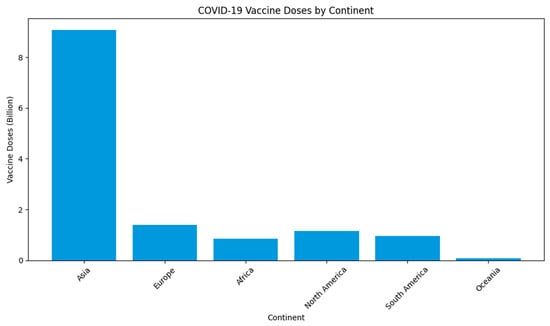You're using an outdated browser. Please upgrade to a modern browser for the best experience.
Please note this is a comparison between Version 1 by Elijah Kolawole Oladipo and Version 2 by Rita Xu.
The rampant spread of the COVID-19 infection poses a grave and formidable challenge to global healthcare, with particular concern to the inhabitants of the African continent. In response to these pressing concerns, different strategies have been employed to combat the emergence of this insidious disease, encompassing crucial measures such as physical distancing, the utilization of face masks, meticulous hand hygiene, and widespread vaccination campaigns.
- transfer
- COVID-19
- technology
- vaccine
1. Introduction
The COVID-19 pandemic, an all-encompassing global threat, has left no region untouched in the entire world [1]. As of 9 July 2023, the tally of confirmed COVID-19 cases stands at a staggering of 767,972,961, with a heart-wrenching death toll of approximately 6,950,655 worldwide [2]. Data profiles from the World Health Organization (WHO) in data records, as shown in Table 1, further shows the recorded cases across the population, as alarming reports continue to pour in regarding the surge of COVID-19 cases in low- and middle-income countries (LMICs) like Bangladesh, Cameroon, the Democratic Republic of Congo, India, Indonesia, Nigeria, Mali, Gambia, Senegal, Ghana, Sudan, Tunisia, and various other African nations [3][4][3,4]. Africa, in particular, has confirmed cases of 9,542,363 and the death toll reaching 175,399 as of 9 July 2023. Tragically, the scarcity or absence of COVID-19 vaccines in many nations has translated into an escalating number of lives lost. In the initial stages of the pandemic, when neither a COVID-19 vaccine nor treatment options were known, the concept of herd immunity emerged as a potential remedy for combating the SARS-CoV-2 virus [1].
Table 1. COVID-19 cases in each continent and the respective population size as of 16 August 2023.
| WHO Regions | Total Cases (Million) | Population (Billion) |
|---|---|---|
| Europe | 249.09 | 0.74481 |
| Asia | 299.92 | 4.72 |
| North America | 124.41 | 0.60032 |
| South America | 68.8 | 0.43882 |
| Africa | 13.11 | 1.43 |
| Oceania | 14.43 | 0.04504 |
Amidst this relentless surge, multiple nations have made significant strides in developing vaccines against the disease. Notably, certain high-income countries (HICs) have made remarkable progress in the manufacturing and development of COVID-19 vaccines [5]. Concurrently, numerous vaccine candidates have received emergency use authorizations, leading some countries to commence extensive vaccination campaigns [5]. However, the mere existence of licensed vaccines falls short of achieving global control over COVID-19. It is imperative to ramp up production on a larger scale, ensuring affordability, broad coverage, and equitable distribution across the global population. This encompasses addressing the evolving genetic makeup of the virus, particularly in Africa, where unique host—virus interactions have given rise to new variants [6]. Consequently, the World Health Organization (WHO) and its collaborative partners have diligently worked towards enhancing worldwide access to COVID-19 vaccines. Their efforts involve bolstering the capabilities of low- and middle-income countries (LMICs) to facilitate vaccine production, thereby curbing the pandemic’s impact [7].
To facilitate the manufacturing process of LMICs, the WHO is launching a project in South Africa, providing technical expertise for vaccine production, empowering the continent to combat the epidemic, and attain self-sufficiency [8]. The success of vaccine technology transfer to Africa hinges upon the region’s preparedness to embrace this knowledge hub, with far-reaching implications for the vaccine’s efficacy. The implementation of effective strategies is essential to overcome barriers hindering the seamless transmission of expertise.
2. Rationale for COVID-19 Vaccine Technology Transfer in Africa
On 11 March 2020, the World Health Organization (WHO) officially declared the COVID-19 pandemic, marking a turning point in global health [9]. Notably, as of 18 November 2022, Africa accounted for 3.48% of the total worldwide infections, with 12,693,549 confirmed cases. South Africa bore the brunt of the outbreak on the African continent, reporting approximately 4,036,623 infections, making it the most heavily impacted country on the continent [10]. It is important to note that Africa’s lower number of confirmed cases and death rates compared to other continents may be attributed to limited COVID-19 testing, which skews the incidence rate and fails to provide an accurate depiction of the outbreak’s magnitude [9]. Infectious diseases remain a leading cause of death in Africa and Asia, particularly among children under the age of five. In 2016, Sub-Saharan African countries accounted for 44.4% of all child fatalities, while South Asian countries accounted for 248%. Shockingly, children in low- and middle-income nations face a mortality risk 34 times higher than their counterparts in high-income countries [11]. This underscores the urgent need for targeted interventions and healthcare improvements to safeguard the well-being of vulnerable populations in these regions. At the end of June 2023, an estimation of 13 billion vaccine doses had been administered worldwide, with a meagre 0.2% allocated to low-income countries, especially in Africa and the Oceania continent, as depicted in Figure 1 below [12]. WHO statistics, as reported by Id and colleagues [3] in 2020, revealed the ongoing spread of COVID-19 in densely populated regions of Ghana, Nigeria, the Democratic Republic of Congo, and potentially across the African continent. This emphasises the imperative of a global commitment to developing a safe and affordable COVID-19 vaccine, with a particular emphasis on prioritizing vaccination efforts in African nations. Dr. Seth Berkley, the CEO of GAVI (the Vaccine Alliance), has underscored the crucial importance of addressing the specific vaccine needs of these African countries, making it an urgent global priority.
Figure 1. Total COVID-19 vaccine doses (billion) across the continent.
